USAF successfully launch the new GPS IIF-1 satellite
Article by: Mike Barrett
Date: 29 May 2010
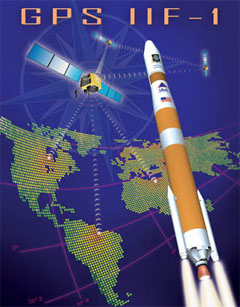 Last night saw the successful launch and deployment of a new generation of GPS satellites the GPS IIF. These satellites are built by Boeing and will enhance the current GPS constellation by adding a further 12 GPS satellites to replace the current ones that are nearing the end of their service life. Last night saw the successful launch and deployment of a new generation of GPS satellites the GPS IIF. These satellites are built by Boeing and will enhance the current GPS constellation by adding a further 12 GPS satellites to replace the current ones that are nearing the end of their service life.
This launch was particularly important for a number of reasons: It was to be the first of the new GPS Satellites; It represented a major milestone for the Delta Rockets; and it was to be the first GPS launch on the Delta IV rocket.
The full pre-launch and launch day events follow along with our GPS IIF-1 launch video:
I had arranged to come out to Florida last year to witness this launch but it was postponed from November to February, finally to May 13th. May 13th was a particularly poignant date as this represented the 50th anniversary of the Delta family of rockets. Unfortunately due to the final flight of the Space Shuttle Atlantis this date was pushed out to May 20th.
GatorGuy and I were invited by the USAF to attend a pre-launch press conference on launch pad 37 at the Cape Canaveral Air Force Base 12 hours before the launch. We headed out the the meeting point outside the security barriers of the AFB where we were met by our Air Force escorts (including Dan @AFSpace on Twitter). With about 25 other reporters we were take out to the Launch Complex in a large convoy.
We were fortunate enough to be escorted by Eric who gave us a commentary of the (unrestricted) areas as we passed by. These included hangers that are now military museums, the docks where the Space Shuttle SRBs are returned to, the ordnance store where all the pyrotechnics involved with rockets are kept etc.
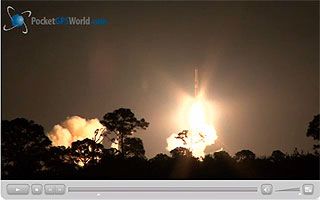
Click here for our launch video
Interestingly the Cape Canaveral AFB is massive area that is home to a wealth of wildlife that is effectively protected 24/7. We saw all types of birds and other animals while we were there.
As we approached the launch pad we saw the Rocket Integration Building which is where the various parts of the rocket are assembled prior to being rolled out to the launch pad. This integration building is somewhat different to normal stack integration facilities in that it is horizontal rather than vertical. It is claimed that this houses the flattest floor in the world with a difference of less than 1/8" over it's surface. The rocket is assembled here prior to being hoisted into a vertical position ready for the short trip to the pad.
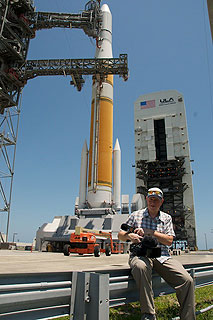 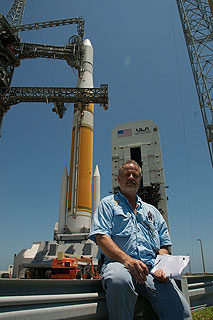
Arriving at the launch pad we found that the protective tower had already been rolled away and the rocket was freestanding connected by the umbilical to the ground systems. Standing at about 211 feet the rocket towered over us. Detailed in orange over white the Delta IV had the US Flag and the logos of United Launch Alliance who provide the rocket, Boeing who provide the GPS satellite and the USAF GPS Wing who will commission and maintain the satellite. There was a loud hissing noise coming from the pipework under the launch pad apparently this is normal…
We were given free access to the launch pad and both GatorGuy and I did the tourist thing and had our pictures taken standing just 70 feet from the rocket. We were also able to see other aspects of the launch pad, including the flame trench that channels the exhaust and flames from the rocket on ignition. This is definitely a place you don't want to be at launch time. In fact the entire area is cleared for over 2.5 miles. This is mainly due to the toxic effects of the combustion of the fuel and other matter when the engines ate lit. Just about all the reporters offered to sign releases to allow us closer to the pad for the launch, but strangely they were turned down…
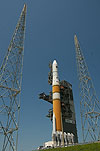 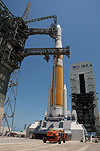 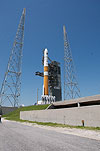
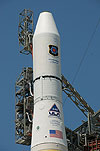 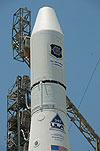 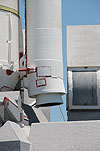
Click on images for larger view
After our visit to the launch pad we had about 7 hours to kill before we had to re-group for the launch. Scheduled for 11:27 we needed to meet outside the NASA Kennedy Space Center at 9:30 for security procedures. When all was set we once again drove in convoy onto the NASA site and headed out to the KSC Press Site where you see the US flag and the countdown clock for Shuttle launches. We spent some time there chatting to the Air Force guys in charge of the launch and to the Boeing representatives who built the GPS satellite.
The rocket can only be launched during a set time period (called the launch window) on a specific day. The launch window extended from 11:27 to 11:43 giving the launch director a number of options should they need the time. As usual they were shooting for the opening of the window at 11:27.
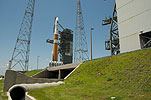 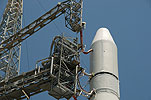 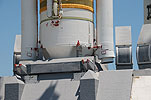
Click on images for larger view
With about 45 minutes to go we were convoyed out to the forward viewing position about 6.5 miles away from Launch Pad 37, which was now lit by powerful Xenon search lights. This was at a boat dock near the Shuttle Viewing platform just off the crawlerway. We had a full view of the rocket on the pad, which was also lit by a full moon. With a 100% go for weather things were looking good for a first time launch.
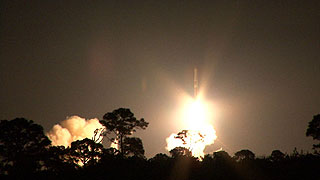 The countdown proceeded well entering the 15 minute hold at T-5 minutes when the final checks for launch were confirmed. We could hear the weather planes checking out the clouds that were drifting towards the launch area, but there was no risk to the launch. At 11:22 the terminal countdown re-started at T-5 and started to count down. The Delta IV was switched to internal power for it's various systems. As the launch director was polling the various stations the officer responsible for satellite telemetry reported an issue. This caused a hold in the countdown with the clock being reset to T-5 minutes. The countdown proceeded well entering the 15 minute hold at T-5 minutes when the final checks for launch were confirmed. We could hear the weather planes checking out the clouds that were drifting towards the launch area, but there was no risk to the launch. At 11:22 the terminal countdown re-started at T-5 and started to count down. The Delta IV was switched to internal power for it's various systems. As the launch director was polling the various stations the officer responsible for satellite telemetry reported an issue. This caused a hold in the countdown with the clock being reset to T-5 minutes.
A new launch time was set for 11:43 and the engineers work on the telemetry issue hoping to get a fix by the 11:38 when we would come out of the hold and resume countdown. At 11:38 the count was restarted and the stations polled. Unfortunately the satellite telemetry was still failing. This resulted in the launch being aborted (or scrubbed) for the night as there was no time to fix the issue before the window closed.
Image credit: Richard Weakley/ERAU Avion Newspaper
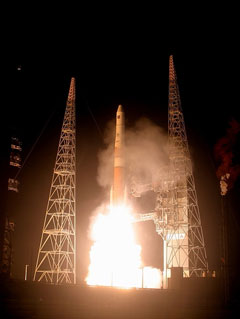 Somewhat despondent we returned to the Press Center to find out what had happened and when the next launch attempt wolf be made. Apparently as the rocket was switched to internal power a vital communication link failed. They needed to work out what had happened before they could re-schedule. The only things that were happy that night were the mosquitoes which had had an excellent meal, and the large alligator in the lagoon that though he might get a good meal. Somewhat despondent we returned to the Press Center to find out what had happened and when the next launch attempt wolf be made. Apparently as the rocket was switched to internal power a vital communication link failed. They needed to work out what had happened before they could re-schedule. The only things that were happy that night were the mosquitoes which had had an excellent meal, and the large alligator in the lagoon that though he might get a good meal.
The next launch was set for Sunday 23rd May. As GatorGuy was making his way to my place to head out to the press site we found that they had already scrubbed the launch for the night. Things were starting to get a bit tight, with the return of Atlantis the tracking stations needed 18 hours to reset between launches making Monday night the last possible slot before the shuttle came home.
GatorGuy was not able to make the Monday launch attempt so I headed out on my own. It turned out to be a wasted trip although it was 2 seconds away from the point of no return when at T-7 seconds the launch was scrubbed. This time it was because the telemetry from the solid rocket boosters failed. This is a very critical link as the boosters have steerable nozzles to keep the rocket on the projected flight path.
Now I was starting to get a bit nervous the shuttle meant that there was no open slot until Thursday at the earliest and on Friday there was a SpaceX test flight. Things were getting tight, and there was a rumor going around that the shuttle may come back a day later… As it happened the Atlantis touched down on time and our next window opened at 11:13 on Thursday.
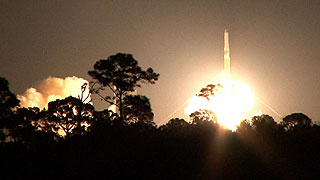 I headed out once again to the Kennedy Space Center, not feeling too optimistic bearing in mind all the thousands of things that need to be 100% for a launch compared to the 1 little thing that could scrub it. This time our viewing position was not as good. We had to view the launch a few hundred yards from the Press site. There was only a partial view of the upper parts of the launch pad. The weather was clear though and not as humid and hazy as the other days. I headed out once again to the Kennedy Space Center, not feeling too optimistic bearing in mind all the thousands of things that need to be 100% for a launch compared to the 1 little thing that could scrub it. This time our viewing position was not as good. We had to view the launch a few hundred yards from the Press site. There was only a partial view of the upper parts of the launch pad. The weather was clear though and not as humid and hazy as the other days.
The best shots were to be got from a height and as the boat was already full of photographers I crept off to some old rotten railway sleepers forming some kind of storage bins for dirt. I managed to get an increase of 5 feet or so and get a partial view of the Delta IV. I was balanced precariously on a small platform of dry rotten wood that I could hear creaking and breaking under my weight. But what the heck I had a great view…
As there was no audio feed out there we had to follow the launch by cellphone. I was a little more organized and had my iPad streaming the KSC launch commentary into my camera and then onto my headphones. There was a delay of about 7-8 seconds but at least I knew what was happening. At 11:08 we came out of the hold and picked up the countdown at T-5 minutes. This time we had green across the board everything was good to go.
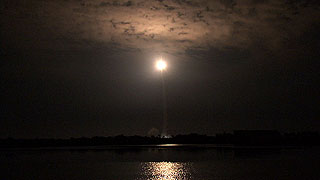 The rest of the countdown continued smoothly. When we got to T-5 seconds the main engine was lit and the point of no-return was reached. Today was the day! The sky was turned a bright orange as the engine reached maximum power, but the rocket was still held in place until: T-0 The two solid rocket boosters lit up and the rocket was finally released and started a slow climb into the night skies. The rest of the countdown continued smoothly. When we got to T-5 seconds the main engine was lit and the point of no-return was reached. Today was the day! The sky was turned a bright orange as the engine reached maximum power, but the rocket was still held in place until: T-0 The two solid rocket boosters lit up and the rocket was finally released and started a slow climb into the night skies.
As the Delta IV rocket accelerated it penetrated a layer of clouds. This was about 30 seconds after liftoff and we were concerned that we would lose sight of the rocket for the rest of it's flight. As it passed through the clouds it lit them with some nice effects, after another 30 seconds it emerged from the other side of the clouds, and somehow I was still tracking it on the video.
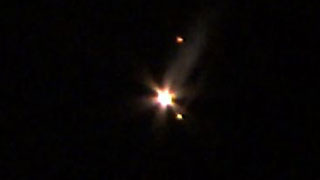 One minute 40 seconds into the light we see a flare as the solid rocket boosters burn out and are separated from the main rocket. These can be seen clearly on the video as they are jettisoned and start tumbling into the Atlantic ocean. One minute 40 seconds into the light we see a flare as the solid rocket boosters burn out and are separated from the main rocket. These can be seen clearly on the video as they are jettisoned and start tumbling into the Atlantic ocean.
Shortly after we lose sight of the rocket as it approaches 50 miles from the launch pad and continues on its journey into orbit. It will be another 2.5 minutes before the main engine shuts down and is separated from the second stage. A few seconds after separation the second stage engine ignites taking the satellite into a parking orbit 12 minutes after liftoff. It will be a further 3 hours 20 minutes or so before the GPS IIF-1 satellite splits form the upper stage of the Delta IV and is in the correct orbit.
Image credit: Richard Weakley/ERAU Avion Newspaper
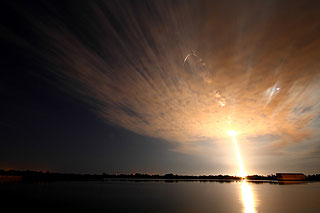 Now that the satellite has been successfully inserted into orbit it will start to go through commissioning testing before being added into the operational constellation of existing GPS satellites. This shakedown is expected to take between 3 and 4 months to complete. Now that the satellite has been successfully inserted into orbit it will start to go through commissioning testing before being added into the operational constellation of existing GPS satellites. This shakedown is expected to take between 3 and 4 months to complete.
My thanks go to the staff at Patrick Air Force Base 45th Space Wing and at NASA's Kennedy Space Center for providing us with access for coverage of the event, United Launch Alliance for the launch commentary and to GatorGuy for commandeering my camera and taking the launch pad photos. Photo credit for the photo left and the rocket at launch: Richard Weakley/ERAU Avion Newspaper.
GO DELTA IV, GO GPS IIF-1 (at long last) The USAF now have an aggressive launch schedule to get the remaining 11 GPS IIF satellites operational over the next few years.
| Comments
|
 Posted by The Rudd on Sat May 29, 2010 6:38 am Posted by The Rudd on Sat May 29, 2010 6:38 am |
 |
Mike
What a fascinating article and pictures , it just goes to show how much respect that there is for PGPSW to be invited to a launch such as this.
Very very good.
Jerry
|
|
 Posted by Tom59 on Sat May 29, 2010 10:14 pm Posted by Tom59 on Sat May 29, 2010 10:14 pm |
 |
I would just like to echo Jerry's comments.
Thanks for bringing this to us all Mike.
TT Go 720 (T)
Firmware 9.430. Map: Western Europe V 875.3613
TT iPhone app
V 1.23 Map: Western and Central Europe 2 GB V 965.7286
TT iOS Go Mobile
V 1.1 Map: Western Europe 965.7248 |
|
 Posted by MikeB on Sun May 30, 2010 10:47 pm Posted by MikeB on Sun May 30, 2010 10:47 pm |
 |
Unfortunately I will not be able to make the next launch. My son is getting married a few days before and for some reason my wife thinks that is more important. She needs to get her priorities sorted...
Mind you she was gracious enough to wave goodbye to me on our wedding anniversary so hat I could attend the launch.
Mike Barrett |
|
 Posted by MichaelCahill on Mon May 31, 2010 10:51 pm Posted by MichaelCahill on Mon May 31, 2010 10:51 pm |
 |
It was mentioned somewhere (maybe a previous article here about launch) that the new generation of satallites would improve GPS accuracy.
Does this refer to new, more sensitive sat-navs in development or could it have an effect on existing models also?
|
|
 Posted by MikeB on Tue Jun 01, 2010 11:54 am Posted by MikeB on Tue Jun 01, 2010 11:54 am |
 |
| MichaelCahill Wrote: | It was mentioned somewhere (maybe a previous article here about launch) that the new generation of satallites would improve GPS accuracy.
Does this refer to new, more sensitive sat-navs in development or could it have an effect on existing models also? |
I am in the middle of writing another article about the new satellites, but basically they will produce stronger signals which will benefit all GPS users.
Mike Barrett |
|
|
|
 |
|